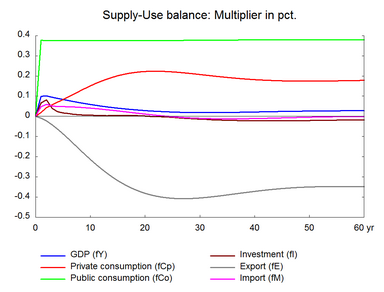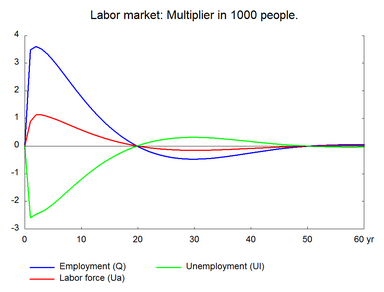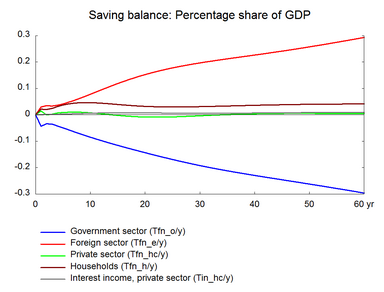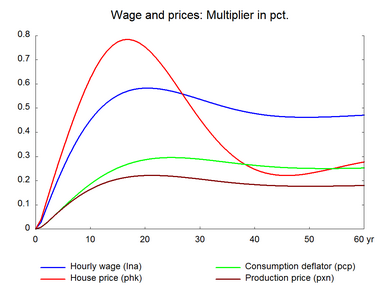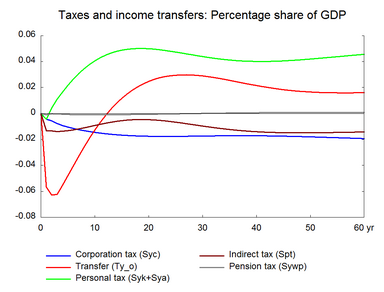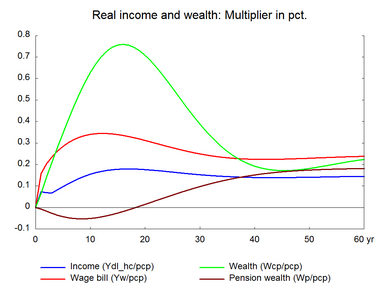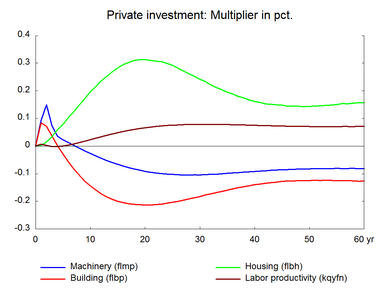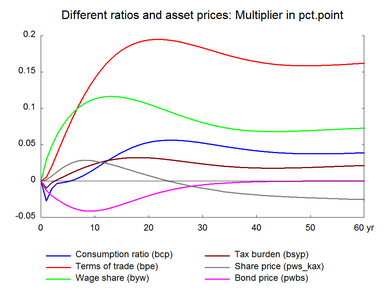Salaries are a major part of general government expenditures. Table 2 presents the effect of a permanent increase in general government employment and salaries. The payroll in the public sector is increased by 1000 millions kroner in 2000 prices, which provides an additional employment in the public sector of 2370 persons, approximately equal to 0.1 per cent of the total employment. (See experiment)
Table 2. The effect of an increase in general government employment
| 1. yr | 2. yr | 3. yr | 4. yr | 5. yr | 10. yr | 15. yr | 20. yr | 25. yr | 30. yr | ||
| Million 2005-kr. | |||||||||||
| Priv. consumption | fCp | 145 | 339 | 458 | 571 | 686 | 1342 | 1927 | 2294 | 2451 | 2484 |
| Pub. consumption | fCo | 1407 | 1421 | 1441 | 1463 | 1486 | 1600 | 1722 | 1856 | 2005 | 2167 |
| Investment | fI | 198 | 250 | 126 | 74 | 55 | 21 | 16 | 7 | -20 | -67 |
| Export | fE | -71 | -178 | -326 | -501 | -699 | -1854 | -2966 | -3816 | -4366 | -4674 |
| Import | fM | 362 | 464 | 412 | 397 | 400 | 365 | 259 | 117 | -18 | -117 |
| GDP | fY | 1421 | 1482 | 1413 | 1349 | 1284 | 971 | 720 | 545 | 441 | 410 |
| 1000 Persons | |||||||||||
| Employment | Q | 3.48 | 3.60 | 3.51 | 3.33 | 3.10 | 1.79 | 0.69 | -0.01 | -0.37 | -0.47 |
| Unemployment | Ul | -2.59 | -2.47 | -2.38 | -2.26 | -2.10 | -1.20 | -0.46 | 0.01 | 0.25 | 0.32 |
| Percent of GDP | |||||||||||
| Pub. budget balance | Tfn_o/Y | -0.04 | -0.03 | -0.04 | -0.04 | -0.05 | -0.08 | -0.12 | -0.14 | -0.17 | -0.19 |
| Priv. saving surplus | Tfn_hc/Y | 0.01 | 0.00 | 0.00 | 0.01 | 0.01 | 0.01 | 0.00 | -0.01 | -0.01 | 0.00 |
| Balance of payments | Enl/Y | -0.03 | -0.03 | -0.03 | -0.04 | -0.04 | -0.08 | -0.12 | -0.15 | -0.18 | -0.20 |
| Foreign receivables | Wnnb_e/Y | -0.01 | -0.05 | -0.08 | -0.12 | -0.15 | -0.42 | -0.82 | -1.34 | -1.90 | -2.47 |
| Bond debt | Wbd_os_z/Y | 0.00 | 0.02 | 0.04 | 0.07 | 0.10 | 0.36 | 0.73 | 1.18 | 1.67 | 2.20 |
| Percent | |||||||||||
| Capital intensity | fKn/fX | -0.08 | -0.08 | -0.06 | -0.05 | -0.04 | 0.01 | 0.04 | 0.07 | 0.08 | 0.08 |
| Labour intensity | hq/fX | 0.04 | 0.04 | 0.05 | 0.05 | 0.06 | 0.05 | 0.05 | 0.04 | 0.04 | 0.04 |
| User cost | uim | 0.01 | 0.02 | 0.04 | 0.06 | 0.07 | 0.14 | 0.18 | 0.19 | 0.19 | 0.18 |
| Wage | lna | 0.03 | 0.09 | 0.15 | 0.20 | 0.25 | 0.45 | 0.55 | 0.58 | 0.57 | 0.54 |
| Consumption price | pcp | 0.01 | 0.02 | 0.05 | 0.07 | 0.09 | 0.19 | 0.25 | 0.29 | 0.30 | 0.29 |
| Terms of trade | bpe | 0.00 | 0.02 | 0.03 | 0.05 | 0.07 | 0.13 | 0.17 | 0.18 | 0.18 | 0.17 |
| Percentage-point | |||||||||||
| Consumption ratio | bcp | -0.03 | -0.01 | 0.00 | 0.00 | 0.00 | 0.02 | 0.04 | 0.05 | 0.06 | 0.05 |
| Wage ratio | byw | 0.03 | 0.05 | 0.06 | 0.08 | 0.09 | 0.11 | 0.12 | 0.11 | 0.09 | 0.08 |
An increase in public sector employment lifts total employment and the overall wage bill. More income creates higher demand. Higher demand expands domestic production and employment further. Just like the experiment in section 1 the income multiplier reinforces itself to create higher demand and higher employment.
Compared to the public purchase of goods and services experiment, the effect on employment and income is stronger in the present experiment. An increase in public purchase increases imports, and hence part of the public expenditure initially goes into foreign production and foreign employment. In the present shock all initial expenditures go directly into domestic employment. In the short term, the employment effect is approximately twice as large compared to the first experiment.
A rapid increase in employment produces a sharp fall in unemployment. Which necessitates a strong increase in wages leading to a significant deterioration of competitiveness. As a result, the fall in exports is pronounced. Even though the expansionary effect is stronger in the short run, the subsequent fall in net-exports is deeper. Thus, the effect on domestic production is reduced over time and the effect on employment is also reduced at the same rate. Gradually, employment returns to the baseline. The permanent increase in employment in the public sector is offset by a permanent fall in employment in the private sector. The displacement of private employment by public employment is the original definition of crowding out. Therefore, in terms of employment, there is full crowding out in ADAM.
But crowding out is also applied to production and demand. The fall in net exports reduces private production, which roughly corresponds to the increase in government production. The higher government consumption is offset by a reduction in net exports so the increase in total demand is not as high as the increase in public consumption. Government production displaces private production and government consumption displace other demand. In ADAM there is also crowding out in terms of production and demand. But crowding out of production and demand is partial. There is a positive effect on real wages, real disposable income, private consumption and total production in the long run. This is because imports are part of production inputs. Since import prices are unchanged, output prices increase less than wage increases, this creates a real wage effect.
The public finance deteriorates permanently in the long run. If the government chooses to raise taxes in the long run, the higher real wage will not translate to a higher disposable income. The tax increase would reduce the income effect and there will be no permanent positive effect on private consumption and overall domestic production in the long run.
Figure 2. The effect of an increase in general government employment
